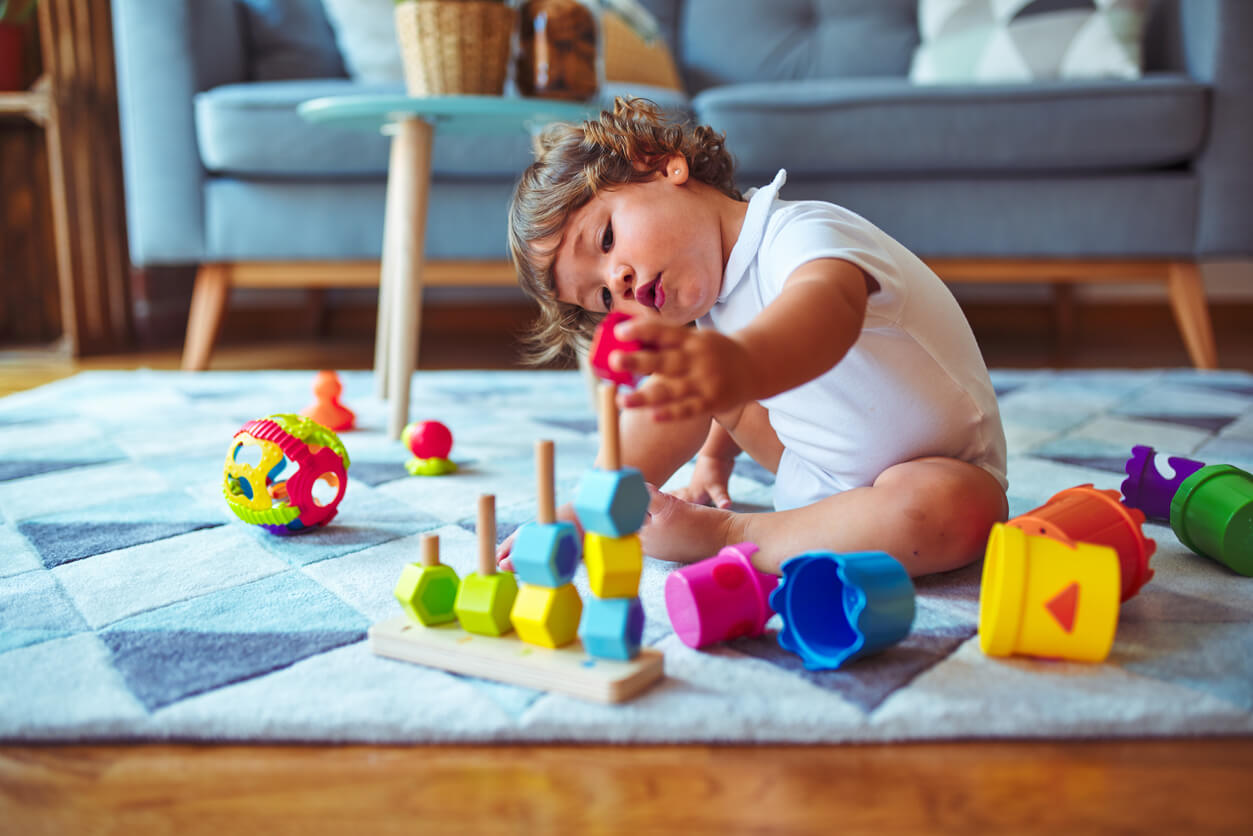The 6 Phases of Play that Children Go Through


Written and verified by the psychologist Elena Sanz Martín
There’s no other activity more natural for children than play. Practically, from the time they’re born, children are involved in these types of activities that aren’t related to survival, but rather pleasure and entertainment. The desire to play is innate and is key to learning and personal development. For this reason, today we want to talk to you about the 6 phases of play and what they consist of.
If you observe two children of different ages, for example, a 2-year-old and a 6-year-old, you’ll see that their ways of playing are very different. This can be confusing if you’re not familiar with the idea that play evolves. So, you may take your little one to the park to socialize with other children and see them watching others without interacting, or perhaps lost in their own dynamics.
Don’t panic in a situation like that–your child probably doesn’t have any sort of socialization problem. Rather, it’s just what corresponds to their evolutionary stage. Keep reading to find out why.
Find out what Mildred Parten’s phases of play are
There are several ways to categorize children’s play and all of them are very valid and of practical use. But one of the most outstanding is the one made by the American sociologist Mildred Parten. Her classification describes different stages through which children’s play passes according to the degree of socialization in which they’re involved.
In 1932, Parten set herself the task of observing the social preparation of preschool children. She found that the type of play that developed differed according to several variables and that the age of the infants is one of the main elements.

1. Unoccupied play
Unoccupied play is typical of infants and young children. At first glance, it may appear as if they’re not playing and nothing’s happening at all. The child simply observes their surroundings or makes random movements. They may choose to follow an adult or focus on playing with their own body, for example, getting in and out of a chair. In addition, despite being offered toys or activities to do, they don’t pay attention to them or show any interest.
2. Bystander play
This kind of play is similar to the previous one. However, in this case, the child doesn’t watch whatever catches their attention in the environment but focuses on observing how a particular group of children play. Therefore, they stay at a safe distance and don’t participate in the activity, but they can talk to them and ask questions or make suggestions. They actually learn about the rules of the game and social interaction.
3. Solitary play
This is a type of individual play in which the child is focused on their own activities and shows no interest in others. They use toys that are different from those of the other toddlers, even if they’re very close to them, and make no attempt at rapprochement or communication. In general, they learn to entertain themself and to be self-sufficient.
4. Parallel play
This is a transitional stage between individual play, which occurs when the child doesn’t yet possess sufficient maturity, communication skills, or participatory or social play. It’s characterized by infants playing close to each other, using the same toys, and imitating each other’s actions. However, each focuses on their own individual play.

5. Associative play
In this case, children already play with each other and are interested in interacting with each other. They share materials, converse with one another, and follow each other in some way, but they don’t coordinate their activities and create individual products. As there’s already a high degree of communication, this type of play encourages the development of language and social skills. It’s typical in the early stages of preschool.
6. Cooperative play
The last of the 6 phases is called cooperative play and occurs when there’s an organized activity involving several children. Dramatizations can be carried out in which each one takes a role and certain rules to be followed are also established. Everyone collaborates to create a shared theme or script and, therefore, it’s a more complex type of play that requires greater maturity. Therefore, cooperative play favors a sense of belonging and helps develop empathy.
The phases of play aren’t always sequential
It’s suggested that these 6 phases of play occur successively as the child grows, but this isn’t entirely clear. And there are other factors that seem to intervene. For one, the greater the opportunities for socialization, the more likely it is that cooperative rather than solitary types of play will emerge. In addition, the degree of trust that exists between children may also favor the appearance of one type of play or another.
It shouldn’t be worrying to see older children getting involved in non-social games on certain occasions. In any case, it’s useful to know how the style of play varies according to the evolutionary stage of the children. Knowing what skills they have and what they need at each age can help parents not to worry about the apparent lack of participation of their little ones with their peers.
Remember that, even if they don’t interact excessively, observation and sharing space with other children also favors the acquisition of important skills.
There’s no other activity more natural for children than play. Practically, from the time they’re born, children are involved in these types of activities that aren’t related to survival, but rather pleasure and entertainment. The desire to play is innate and is key to learning and personal development. For this reason, today we want to talk to you about the 6 phases of play and what they consist of.
If you observe two children of different ages, for example, a 2-year-old and a 6-year-old, you’ll see that their ways of playing are very different. This can be confusing if you’re not familiar with the idea that play evolves. So, you may take your little one to the park to socialize with other children and see them watching others without interacting, or perhaps lost in their own dynamics.
Don’t panic in a situation like that–your child probably doesn’t have any sort of socialization problem. Rather, it’s just what corresponds to their evolutionary stage. Keep reading to find out why.
Find out what Mildred Parten’s phases of play are
There are several ways to categorize children’s play and all of them are very valid and of practical use. But one of the most outstanding is the one made by the American sociologist Mildred Parten. Her classification describes different stages through which children’s play passes according to the degree of socialization in which they’re involved.
In 1932, Parten set herself the task of observing the social preparation of preschool children. She found that the type of play that developed differed according to several variables and that the age of the infants is one of the main elements.

1. Unoccupied play
Unoccupied play is typical of infants and young children. At first glance, it may appear as if they’re not playing and nothing’s happening at all. The child simply observes their surroundings or makes random movements. They may choose to follow an adult or focus on playing with their own body, for example, getting in and out of a chair. In addition, despite being offered toys or activities to do, they don’t pay attention to them or show any interest.
2. Bystander play
This kind of play is similar to the previous one. However, in this case, the child doesn’t watch whatever catches their attention in the environment but focuses on observing how a particular group of children play. Therefore, they stay at a safe distance and don’t participate in the activity, but they can talk to them and ask questions or make suggestions. They actually learn about the rules of the game and social interaction.
3. Solitary play
This is a type of individual play in which the child is focused on their own activities and shows no interest in others. They use toys that are different from those of the other toddlers, even if they’re very close to them, and make no attempt at rapprochement or communication. In general, they learn to entertain themself and to be self-sufficient.
4. Parallel play
This is a transitional stage between individual play, which occurs when the child doesn’t yet possess sufficient maturity, communication skills, or participatory or social play. It’s characterized by infants playing close to each other, using the same toys, and imitating each other’s actions. However, each focuses on their own individual play.

5. Associative play
In this case, children already play with each other and are interested in interacting with each other. They share materials, converse with one another, and follow each other in some way, but they don’t coordinate their activities and create individual products. As there’s already a high degree of communication, this type of play encourages the development of language and social skills. It’s typical in the early stages of preschool.
6. Cooperative play
The last of the 6 phases is called cooperative play and occurs when there’s an organized activity involving several children. Dramatizations can be carried out in which each one takes a role and certain rules to be followed are also established. Everyone collaborates to create a shared theme or script and, therefore, it’s a more complex type of play that requires greater maturity. Therefore, cooperative play favors a sense of belonging and helps develop empathy.
The phases of play aren’t always sequential
It’s suggested that these 6 phases of play occur successively as the child grows, but this isn’t entirely clear. And there are other factors that seem to intervene. For one, the greater the opportunities for socialization, the more likely it is that cooperative rather than solitary types of play will emerge. In addition, the degree of trust that exists between children may also favor the appearance of one type of play or another.
It shouldn’t be worrying to see older children getting involved in non-social games on certain occasions. In any case, it’s useful to know how the style of play varies according to the evolutionary stage of the children. Knowing what skills they have and what they need at each age can help parents not to worry about the apparent lack of participation of their little ones with their peers.
Remember that, even if they don’t interact excessively, observation and sharing space with other children also favors the acquisition of important skills.
All cited sources were thoroughly reviewed by our team to ensure their quality, reliability, currency, and validity. The bibliography of this article was considered reliable and of academic or scientific accuracy.
- Brownell, C. A., Zerwas, S., & Balaram, G. (2002). Peers, cooperative play, and the development of empathy in children. Behavioral and Brain Sciences, 25(1), 28–29. https://doi.org/10.1017/S0140525X02300013
- Parten, M. B. (1932). Social participation among pre-school children. The Journal of Abnormal and Social Psychology, 27(3), 243–269. https://doi.org/10.1037/h0074524
This text is provided for informational purposes only and does not replace consultation with a professional. If in doubt, consult your specialist.








